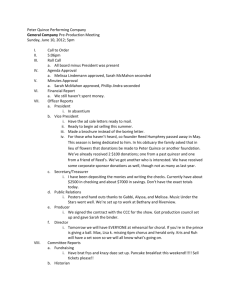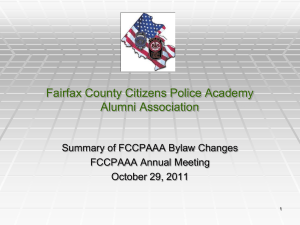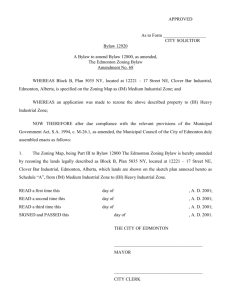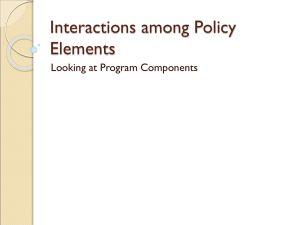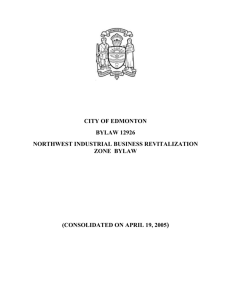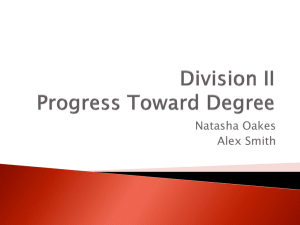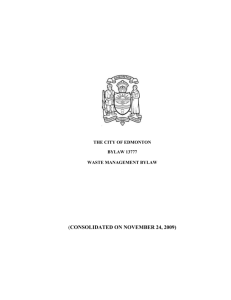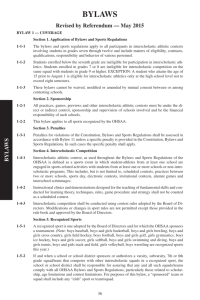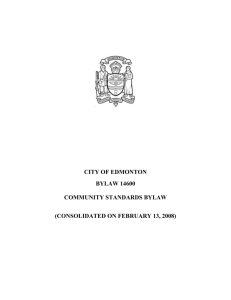Eligibility & Compliance Procedures
advertisement
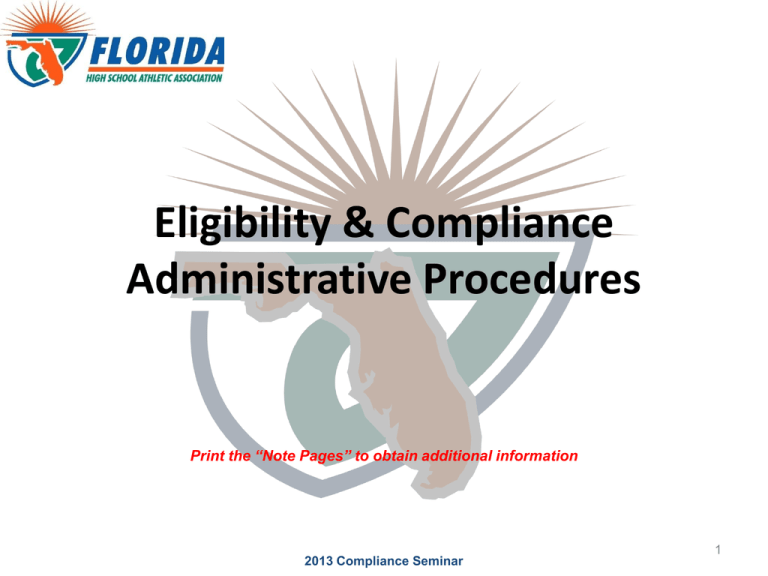
Eligibility & Compliance Administrative Procedures Print the “Note Pages” to obtain additional information 2013 Compliance Seminar 1 AP 1.1 1.1 Establishing School Residence 1.1.1 Traditional Students. A “Traditional” student may participate only in the interscholastic athletic programs sponsored by the school he/she first attends each school year, which is either the school where the student first attends classes or the school where the student first participates in athletic activities on or after the official start date of that sport season before he/she attends classes at any school. The student will have been considered to have established his/her school residence at that school for that school year. School residence is only established once during a school year. 1.1.2 Non-Traditional Students. A “Non-Traditional” student may participate only in the interscholastic athletic programs sponsored by the school he/she first registers his/her intent to participate. As such the student will have been considered to have established his/her school residence at that school for that school year. School residence is only established once during a school year. 2013 Compliance Seminar 2 AP 1.2 1.2 Register Intent. A “Non-Traditional” student must register his/her intent to participate prior to a date, which is not earlier than, the first day of practice for the first sport in which the student wishes to participate. This can be accomplished by the completion and submission of one or more of the following forms: GA4 Form (required only once unless there is a subsequent change in schools) EL7 Form (required only once of home education students unless there is a subsequent change in schools) EL12 Form (required only once of students attending certain small, nonmember private schools) EL14 Form (required only if the student is using “Controlled Open Enrollment” in order to participate at a school other than the school the student is zoned to attend and required only once unless there is a subsequent change in schools ) EL2 Form (required each year and valid for 365 days, unless there is a subsequent change in schools, in which case page one of the form must be completed and submitted) EL3 Form (required each year and valid for 365 days, unless there is a subsequent change in schools) EL3CH Form (required each year and valid for 365 days) 2013 Compliance Seminar 3 AP 1.2 cont’d 1.2.1 Register Intent Only Once. A “Non-Traditional” student needs to register their intent only one time for each sport in which the student wishes to participate. As long as the student remains affiliated with a school in the sport(s) in which intent was originally registered, the student does not need to re-register intent. However, if the student subsequently changes his/her affiliation to a different school, then the student must register intent with the new school prior to a date, which is not earlier than, the first day of practice for the sport(s) in which the student wishes to participate in addition to meeting one of the provisions in Bylaw 9.3.2. 2013 Compliance Seminar 4 AP 1.3 1.3 1.3.1 Transfers Definitions 1.3.1.1 Transfer. A transfer of schools occurs when a student changes the school they attend during the school year (see Bylaw 1.4.5). The student is subject to the transfer provision in Bylaw 9.3. 1.3.1.2 Change of School. A change of schools occurs when a student changes the school they attend during the summer (see Bylaw 1.4.6). The student is subject to provisions of Bylaw 9.2. 1.3.2 Parent/Student Responsibilities. Once the student has completed the transfer (i.e. is attending classes at the new school), the student/parent must: . . . 1.3.3 School Administration Responsibilities. Prior to allowing the student to participate in interscholastic athletics, the school administration must: . . . 2013 Compliance Seminar 5 AP 1.3 cont’d 1.3.3.4 Determine that the student meets one of the six provisions listed in Bylaw 9.3.2 (Note: the student needs to meet only one of the provisions not all of them): 1.3.3.4.1 1.3.3.4.2 1.3.3.4.3 1.3.3.4.4 1.3.3.4.5 1.3.3.4.6 Bylaw Bylaw Bylaw Bylaw Bylaw Bylaw 9.3.2.1 9.3.2.2 9.3.2.3 9.3.2.4 9.3.2.5 9.3.2.6 – – – – – – Transfer before sport season Full and complete move Necessary relocation Marriage of student Reassignment by school district Twenty day rule 2013 Compliance Seminar 6 AP 1.4 1.4 Transcripts 1.4.1 Official Transcripts. Some member schools have different additional graduation requirements related to the school’s curriculum. As a result the member school may not accept certain grades earned by the student prior to attending its institution (i.e. transfer courses). For the purpose of determining academic, athletic eligibility, the school must provide a transcript which includes all of the following: 1.4.1.1 All grades earned by the student since first entering 9th grade must be reflected and used to calculate the student’s athletic eligibility. (Note: some member schools now reflect a weighted GPA, an unweighted GPA and athletic GPA to indicate the student’s GPA). 1.4.1.2 Students required to repeat an academic course or an academic year must have the initial grade earned and the repeated grade earned reflected on the transcript used for athletic eligibility (Note: repeating an academic course or academic year does not extend a student’s limit of eligibility beyond four (4) years). 1.4.1.3 Grades earned in other countries must be reflected on the transcript used for athletic eligibility. 1.4.1.4 Grades earned through virtual programs must be reflected on the transcript used for athletic eligibility. 2013 Compliance Seminar 7 AP 1.4 cont’d 1.4.2 Grade Forgiveness. In accordance with Florida Statutes (s. 1003.428(4)(d) note) and Bylaw 9.4, member schools may enhance a student’s GPA to meet the minimum 2.0 GPA requirement through grade forgiveness. It is important to remember that some member schools and school districts may apply grade forgiveness differently for the purpose of meeting graduating requirements, in the event a student is in danger of not meeting the school’s or school district’s graduation requirements. Athletic Directors must be in communication with their school’s guidance department to ensure grade forgiveness is being applied correctly for the purpose of determining academic, athletic eligibility. The following are some guiding principles for applying grade forgiveness for athletic eligibility: 1.4.2.1 The replacement of a core course must be by a core courses in the same subject and level, i.e. exchange a chemistry grade for a chemistry grade, but not biology grade for a chemistry grade (different levels; science courses are very restrictive); 1.4.2.2 The replacement of a core course by an elective course cannot be done until the requirements of that core has been met and the required electives have been met (this is what impacts graduation); 1.4.2.3 The grade replacing another grade must match by semester, i.e. 2nd semester English I may only replace 2nd semester English I, (it may not replace 1st semester English 1); 1.4.2.4 The grade being used for forgiveness must succeed the grade it is replacing; 1.4.2.5 The grade being used for forgiveness must not be used for a grade during the same semester; 1.4.2.6 Students can enhance a grade in any elective course by taking another elective course, provided the required electives have been met (i.e., keyboarding may replace weightlifting). 2013 Compliance Seminar 8 AP 1.5 1.5 Due Process. Casual conversations with staff, telephone call inquiries and e-mail inquiries concerning student eligibility or possible violations of association rules and regulations are NOT official rulings. 1.5.1 EL10 or EL11 Form. The EL10 – Request for Eligibility Ruling Form – is used when a school is uncertain as to the eligibility of a student based on the bylaws and policies of the association. The EL11 – Request for Sectional Appeals Committee Hearing – is used when the school has determined that a student is ineligible based on the bylaws and policies of the association and the school is seeking a waiver of those bylaws or policies on behalf of the student. The EL11 is also used when a school is seeking a waiver of other violations of the bylaws and policies of the association that are not directly related to student eligibility. It is NOT required that an EL10 Form precede an EL11 Form. 2013 Compliance Seminar 9 AP 1.5 cont’d 1.5.2 When to File an EL10 Form. Student eligibility issues related Bylaw 9.2 (Attendance Requirements) and Bylaw 9.3 (Transfer Regulations) are often times open to interpretation. Uncertainty with these two bylaws would warrant the use of the EL10 Form. Issues related to Bylaw 9.4 (GPA), Bylaw 9.5 (4 year limit of eligibility) and Bylaw 9.6 (age limit) are generally clear cut and would not necessarily warrant the use of the EL10 Form. The use of this form is not required in order to file the EL11 Form if an appeal is requested. Additionally, an EL10 Form should not be filed within 10 business days of the filing deadline for an EL11 Form without filing the EL11 Form as well. It is much easier for the association to pull an appeal hearing then to add an appeal hearing after the EL11 submission deadline has passed. 1.5.3 When to File and EL11 Form. When the school has determined that there has been a clear cut violation of the Bylaws or Policies of the association and the school feels an appeal for a waiver of the violated Bylaws or Policies is justified, then it would be appropriate to file the EL11 Form. Additionally, if a student or parent requests an appeal of an eligibility ruling, the school must honor that request and file an EL11 Form. However, Bylaw 10.4.4 (Undue Hardship Waivers) and following sub-sections should be reviewed, in their entirety, with the student and parent, with particular emphasis on the potential cost to the school (which can be levied to the student/parent by the school) for the appeal being heard by the Section Appeals Committee. 2013 Compliance Seminar 10 AP 1.6 1.6 Combination Schools with Multiple Campuses If a combination school submits documentation, from at least one source in each of the following Levels (for a total of 3 documents, as a minimum) indicating that the combination school is considered as a “single school”, then FHSAA will also consider the combination school to be a “single school”, for the purposes of Bylaw 3.2.2.3: 1.6.1 Federal Level 1.6.1.1 Documentation through the IRS; or 1.6.1.2 Documentation through the Office of Homeland Security; or 1.6.1.3 Documentation through the Federal EEOC (Equal Employment Opportunity Commission). 1.6.2 State Level 1.6.2.1 Documentation through the Florida Department of Education; or 1.6.2.2 Documentation through the Florida Department of Revenue. 1.6.3 Accreditation Level 1.6.3.1 Documentation through FCIS; or 1.6.3.2 Documentation through SACS; or 1.6.3.3 Documentation through one of the FHSAA Approved Accrediting Agencies as listed in Policy 5.3. 2013 Compliance Seminar 11 AP 1.7 1.7 What is a School? 1.7.1 Background. FHSAA member schools are allowed to compete against non-member schools located in the state of Florida. Member schools and coaches must be cautious allowing their teams to compete against other teams which may not be considered a school. 1.7.2 Florida State Statutes. State Statutes clearly define public schools (s. 1003.01(2)), private schools (s. 1002.01(2) and s. 1002.42) and home education programs (s. 1002.01(1) and s. 1002.41). 1.7.3 Florida Department of Education. Public schools, Charter schools, virtual schools, and private schools duly registered with the Florida Department of Education are issued Department of Education identification numbers. A condition of being issued a DOE number is that the school will meet the provisions of F.S. 1002. Home Education Cooperatives are not issued a DOE number, but for the purposes of interscholastic athletics they are considered a school. 2013 Compliance Seminar 12 AP 1.7 cont’d 1.7.4 Interscholastic Athletic Competition. The following serves a guideline for determining if a team represents a school: 1.7.4.1 The school has been issued a Florida Department of Education Identification Number (does not apply to home education cooperative school/teams); and 1.7.4.2 The school provides academic instruction in courses as required in F.S. 1003.43(1); and 1.7.4.3 The school is physically located in the state of Florida; and 1.7.4.4 Course of instruction culminates with conferring a diploma or other recognition of a satisfactorily completed program (except for Home Education Programs). 2013 Compliance Seminar 13 AP 1.8 1.8 Non-Traditional Students 1.8.1 Student Registration Procedures 1.8.1.1 Home Education Students (Bylaw 9.2.2.1). 1.8.1.2 Non-Member Private School Students (Bylaw 9.2.2.5). 1.8.1.3 Charter, Special/Alternative and Florida Virtual School Students (Bylaws 9.2.2.2, 9.2.2.4 and 9.2.2.6). 1.8.2 School Registration Procedures 1.8.1.1 School Registration Process. The school must register each Non-Traditional Student with this association each year before adding the student to a roster and allowing the student to participate in an interscholastic contest. It remains the responsibility of the school to verify the eligibility of all non-traditional students. 1.8.1.2 C2CSchools. The school must input specific information in their C2CSchools database for each non-traditional student. 2013 Compliance Seminar 14 AP 1.9 1.9 Youth Exchange, Other International and Immigrant Students 1.9.1 How to Determine the Type of Student. As with all students participating in interscholastic athletics, the student is required to provide documented proof of age (see Bylaw 9.6.4.1). If that form of documentation is a birth certificate or passport from a foreign country or is a U.S. Visa then additional questions need to be addressed as follows: 1.9.2 Youth Exchange Students. 1.9.3 Other International or Immigrant Students. 2013 Compliance Seminar 15 AP 1.9 cont’d 1.9.4 Student Registration Procedures. The student/school must complete and e-mail a scanned copy of the EL4 Form in addition to scanned copies each of the following: 1.9.4.1 Documented proof age (see Bylaw 9.6.4.1, i.e. ); and 1.9.4.2 The F-1 or J-1 “Eligibility Certificate (Form I-20 AB or Form DS-2019, respectively); and 1.9.4.3 Original language (un-translated) official transcripts since the student entered the 8th grade/year of compulsory education from the school(s) in the student’s home country; and 1.9.4.4 Verbatim translated transcripts since the student entered the 8th grade/year of compulsory education from the school(s) in the student’s home country; and 1.9.4.5 The student/parent/host parent must complete and submit a GA4 Form. 2013 Compliance Seminar 16 Q and A 2013 Compliance Seminar 17
